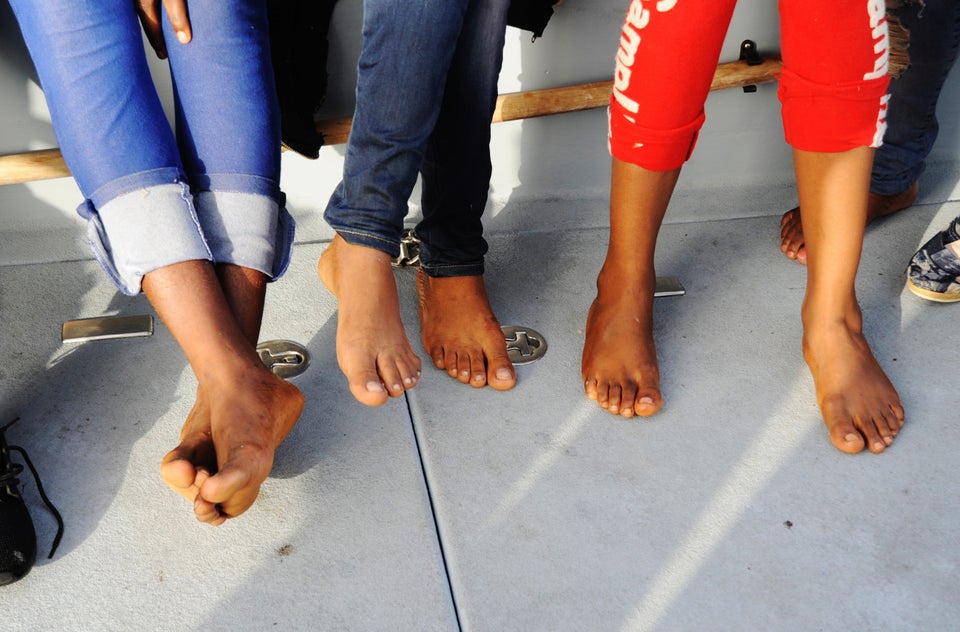The stretch of the Mediterranean Sea separating Libya from southern Italy has become a death trap for some of the world’s most vulnerable people.
Although refugee and migrant arrivals across all of Europe are down compared to last year ― as of Oct. 9, 316,331 migrants and refugees had entered Europe by sea this year, compared to 520,000 by that date in 2015 ― more people have already died, according to the International Organization for Migration. And the year isn’t over yet.
As of Thursday, 3,930 migrants and refugees have died in the Mediterranean this year, according to Doctors Without Borders, also known as Médecins Sans Frontières.
The individual cases are a study in grief. More than 90 people went missing Wednesday after their boat sank just off the coast of Libya. MSF also found 29 people dead in the bottom of a rubber boat in the same area. They had suffocated after inhaling gasoline.
Warning: The tweet below contains graphic imagery that may be upsetting to some readers.
There are several ways to explain the numbers.
For one thing, the Med crossing is one of the only remaining ways into Europe, barring air travel. Most of the safer routes into and through Europe have been shut down.
The European Union and Turkey struck a deal in March that cut off most illegal sea travel between Turkey and Greece. In the Greek islands, where thousands of people were arriving per day as recently as last year, only a few dozen people are rescued each day now.
But something that’s less talked about is the opportunistic nature of the smugglers who control these flows. They are actually making the journey exponentially more dangerous for the travelers.
“Smuggling has become big business: It’s being done on an almost industrial scale,” William Spindler, U.N. Refugee Agency spokesman, said in a statement Tuesday.
Migrants and refugees pay smugglers to get them out of their home countries and into Europe. But most are subject to unspeakable treatment along the way, including torture, rape and starvation.
“We are used to people dying at sea, but before, we would see many wooden boats,” Aurélie Ponthieu, a displacement specialist with MSF, told The WorldPost. “This year, people are suffocating on rubber boats, and they are even worse quality than the wooden ones.”
““Do we keep doing what we do, coming closer, to save people in bad boats? Or do we pull back a bit, watch people drown in the 12-20 mile zone, but hope that the smugglers will change to better boats so fewer people die in the long run?””
- Matteo Zevi, Boat Refugee Foundation
The international community is working to dismantle smuggling networks, but the result is that smugglers sometimes resort to even more dangerous methods.
“Smugglers just use cheaper boats that are terrible quality,” Ponthieu said. “The price is the innocent people who have no choice but to try and cross.”
In recent weeks, she said, smugglers have been capitalizing on the relatively calm sea conditions to send enormous numbers of people out to sea. MSF has seen more arrivals in October than it saw in July or August of this year, even though summer is usually the busiest time.
Ponthieu doesn’t expect the flow to diminish in the coming weeks. “If we have a mild winter, we will continue seeing the same numbers of people,” she said. “The people we’re rescuing have said that there are still tens of thousands waiting in Libya to do the crossing.”

Groups like MSF are fighting a battle they can’t win, Ponthieu said, and “mortality keeps rising because smugglers adapt [to] their methods.”
The Boat Refugee Foundation, another nonprofit conducting rescues in the central Mediterranean, has started focusing its efforts nearer to the Libyan coast, since that’s where it’s detecting boats in distress. As a result, smugglers have decided they don’t need to send people in sturdy boats that are intended to withstand longer journeys.
It forces rescuers to ask themselves unthinkable questions, said Matteo Zevi, a member of the group.
“Do we keep doing what we do, coming closer, to save people in bad boats?” Zevi said in an email to The WorldPost. “Or do we pull back a bit, watch people drown in the 12-20 mile zone, but hope that the smugglers will change to better boats so fewer people die in the long run?”

What makes the problem worse is that by the time a refugee or a migrant steps onto a boat, they’ve likely already been through considerable abuse and hardship. In this weakened state, their odds of surviving at sea are even lower.
“Conditions in Libya continue to deteriorate,” Ponthieu said. “There’s a mounting desperation. So many people we’re seeing who have fled Libya have told stories of being attacked in the street, placed in detention, starved for days.”
And because the area where the rescue ships operate is so vast ― especially compared to the very narrow strait between Turkey and Greece ― some people get rescued only to die during the approximately 36-hour journey from near the Libyan coastline to Italy.
MSF operates two of its own rescue ships, the Bourbon Argos and the Dignity 1. It also partners with other nongovernmental organizations on the rescue ship Aquarius. Its medical resources are extensive, and it has partnered with the Italian government to rescue people at sea via helicopter if their health is seriously at risk. But sometimes people don’t live long enough to make it to shore.
